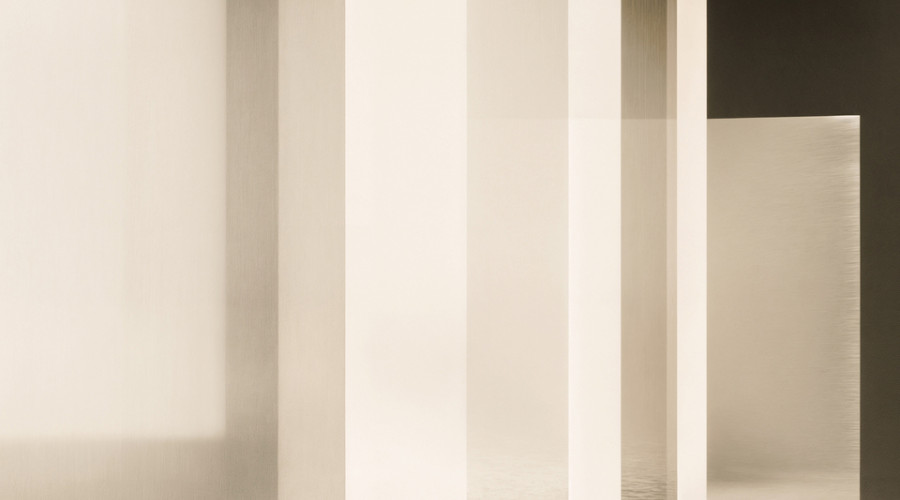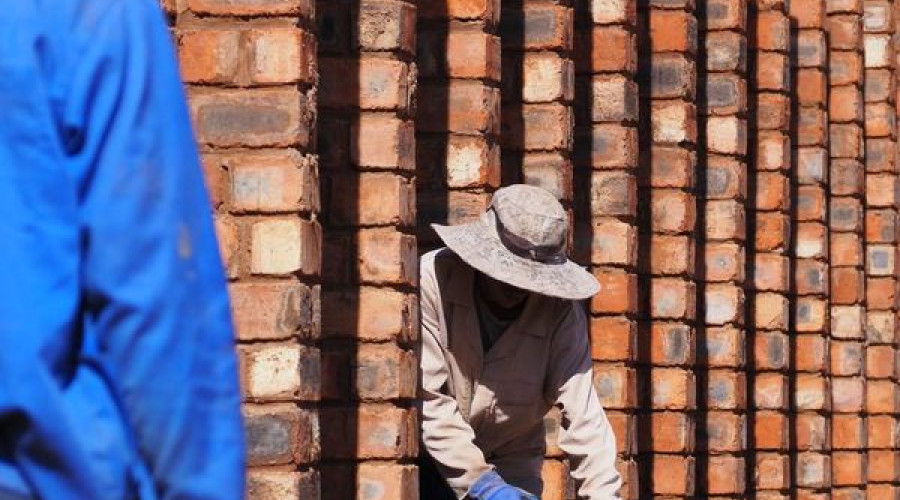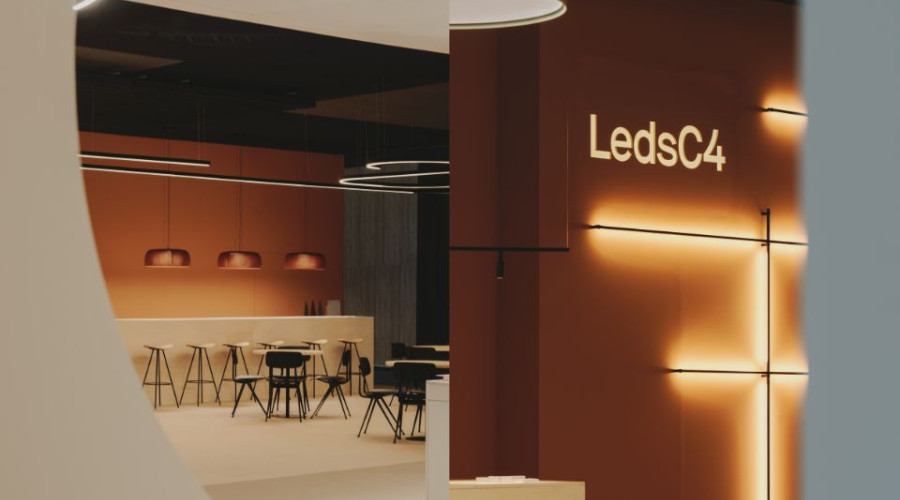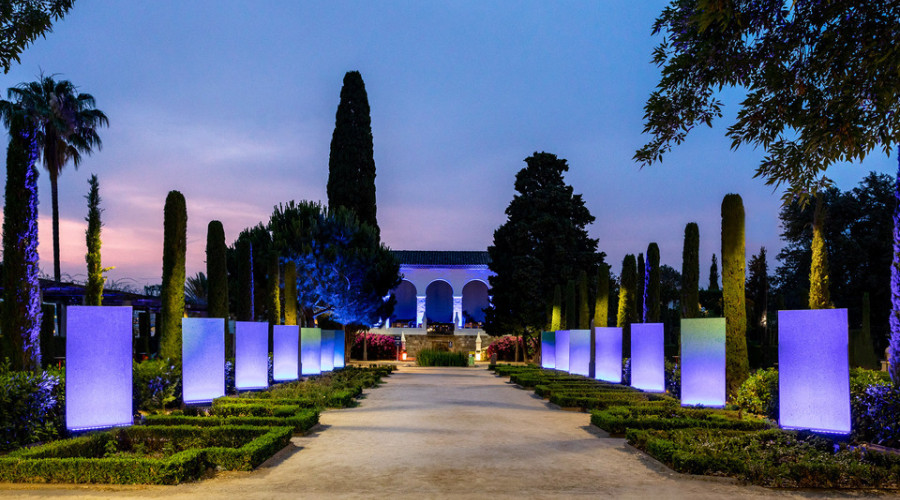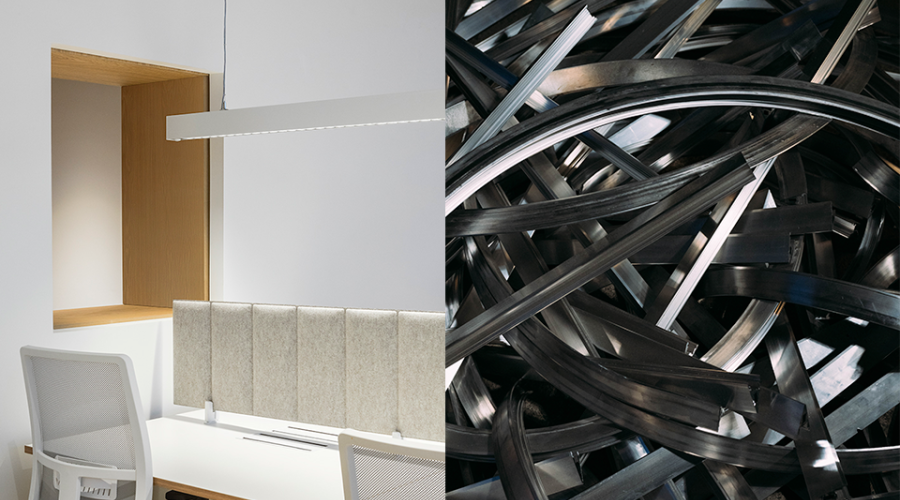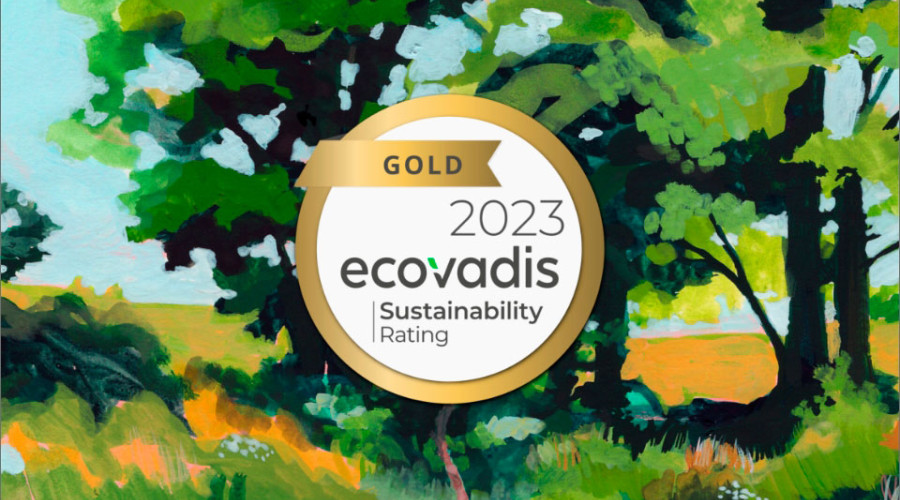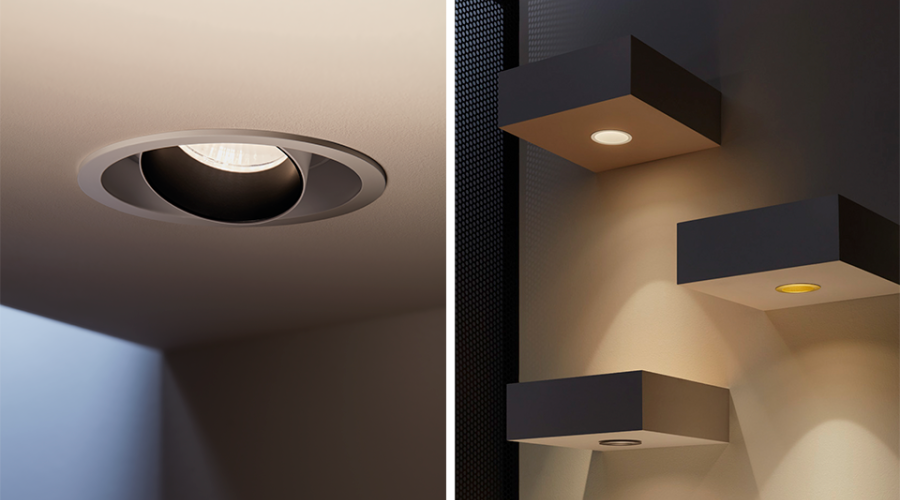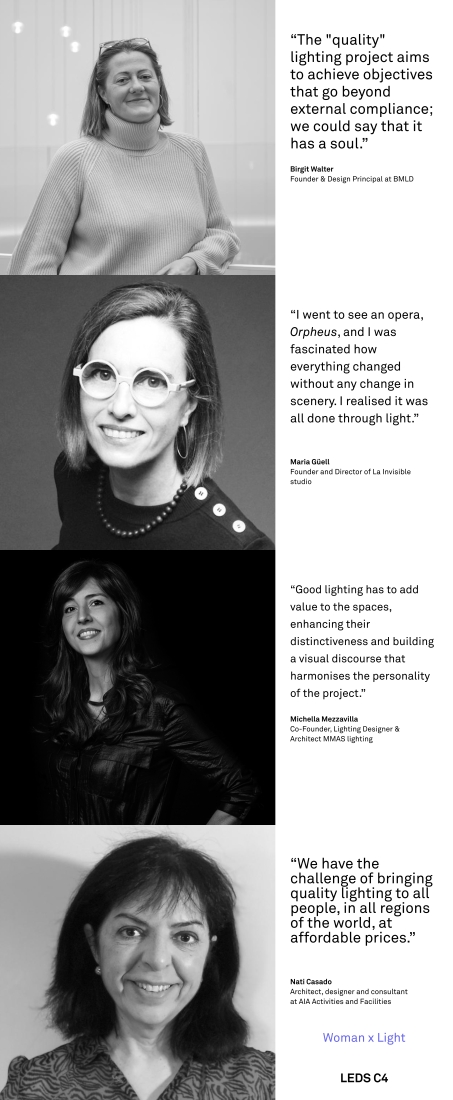
On the occasion of International Women's Day we wanted to interview four great professional women in the field of lighting with whom we have carried out projects and who inspire us and the next generations of lightings.
We spoke with Birgit Walter, founder and creative director of BMLD, as well as co-founder of the Professional Association of Lighting Designers APDI. With her we have participated in projects as incredible as the restaurant area of the Hotel Saint Regis in Doha, and the Fairmont Hotel Rey Juan Carlos I in Barcelona.
The creator of the La Invisible Studio, Maria Güell Ordis, will also give us her vision. With her we recently had the opportunity to work on LlumBCN in 2022.
We have also shared this interview with Michela Mezzavilla, architect and lighting designer, founder of the reMM studio and director of the Lighting Design postgraduate course at the IED Barcelona school.
Natividad Casado, architect, designer and consultant at AIA Arquitectura i instal·lacions, who has accompanied us on projects such as the town hall building in L'Hospitalet de Llobregat and the CEIP Vilablareix in Girona.
What is good lighting/quality lighting for you?
BW: The "quality" lighting project aims to achieve objectives that go beyond external compliance (e.g., regulatory, economic, project). It wants, seeks and accomplishes something more, we could say that it has a "soul". Quality lighting takes care of and selects the type of LED, its PCB, its optics, its relationship with the housing/wrapping/fixture and achieves good colour rendering, quality temperature, optics, efficiency and glare index, and so on.
MM: Good lighting must not only meet functional, regulatory, efficiency and well-being, visual perception and comfort requirements. It also has to add value to the spaces, enhancing their distinctiveness and building a visual discourse that harmonises the personality of the project and facilitates interpretation and enjoyment of the spaces.
NC: Good lighting provides users with a comfortable and healthy environment capable of adapting to whatever activities they are going to do. It guarantees optimum colour reproduction and adapts to the different scenarios and functional needs while enhancing the architectural space.It is also sustainable thanks to the efficiency of the equipment and the regulation and management systems that allow it to adapt to the needs.
What is your inspiration for a lighting project?
BW: I try to link the project to what I sense about the person, the place, the brand, the space, and through this, I let my imagination run wild. Each project is unrepeatable, even if it is for the same client, there are always other stimuli, due to location, sun orientation, people and teams involved and also because we are in another period of life.
MGO: Que es diseñar el espacio en el que vivimos, compartimos y disfrutamos de la belleza y la luz juega un gran papel.
MM: I've realised that when I do a lighting project, what I'm looking for is to dream, or perhaps to play. When I imagine a lighting project, it's like picturing a story, where each place has its own personality and the light moves between the spaces like the narrative of a story, through hierarchies, contrasts, or agreements. I enjoy building systems of visual rules and relationships of contrasts, which then construct spaces, which in turn generate sensations and emotions for people. My inspiration for this is the story that each project carries with it, and this is different in each case. It is the story or the personality of the project that inspires me to choose the light that will best interact with it.
NC: I am inspired by the architectural space and the interaction with natural lighting, as well as imagining the different activities that will take place. It also inspires me to think about how the building is viewed and enjoyed at night.It is essential to know the architect's lighting concept and the client's requirements so that the solution is holistic, enhances the space and makes it unique. I am helped by references from other projects, always with the aim of creating a particular lighting for this new space.
What other women are role models for you? Whether that be in lighting or other disciplines?
BW: The list is exceptionally long! Let's start with my mother, who is a fighter and a great inspiration for me, and all the women who dare to investigate and are what they want to be, the great companions and teachers I have met in my life.... The list is very long, and I am infinitely grateful to all of them. I would like to take this opportunity to thank some of them for the impact they have left on me through the guidance they have given me. Barbara Horton during my early career as a professional at HLB in NYC, Amy Samuelson great teacher with an infinite love for her work, at Parsons School of Design, my great friend Jules Gim (NYC) who has always, always fought with love for what she has wanted, Prachiti Kinikar, Ayurvedic teacher for her wisdom and perseverance, Anna Sabaté, magician, trainer and actress, for all your dedication, love and wisdom, for giving me the tools to know myself, to grow, to believe in myself and to start my amazing journey - to love myself.
MM: There are many women I admire from the lighting sector. It is a source of pride to see that there are more and more of us in this sector every day. I would especially like to mention three people who are my reference points and a source of professional and personal inspiration: the lighting designer Maria Güell, who with the Llum BCN Festival and her personal vision contributes a great deal to the culture of light; Esther Torelló, director of Lightecture, who with her communication work has become a spokesperson in the world for the value of our profession; and finally, Mariel Fuentes, the current President of APDI, a great professional and a great woman. The admiration I have for her is so great that after several years of spontaneous collaboration between our studios, we have decided to join forces and set up a joint project: MMAS lighting, which is just seeing the light of day these days. We are so excited to share it with you!
NC: My reference points are honest and motivated women who work to find solutions that meet people's needs and bring beauty to the environment in which we live. I am extremely interested in María Güell because of her originality in the field of lighting. In other fields, Carme Ruscalleda, a chef, is a great reference for me for her way of understanding and practising cooking (choice of food, tradition and modernity, cooking to be happy, details to the end...).
How do you see the role of women in the sector? How could it be encouraged more?
BW: As in many professions, by qualification, there are more female lighting designers than lighting designers. The problem we have in Spain is that the profession today does not have all the support that it should have. There are many projects that continue to be solved through the manufacturer's or distributor's project. The problem is that the projects that are looking for that extra plus, that project in which time and resources should be invested, should be done by a lighting designer, and for that, a contract and a budget are required, just like for an architect. When this is focused and there really is more work, which is what it should be, I am convinced that there will be more professionals, including many women, who will "take the plunge". I see entrepreneurship in general as overly complicated for men and women in this country. It takes a lot of courage and perseverance.
MM: There are more and more women working in the lighting industry. I would say that there are even more women than men in my sector.
I think that women's presence in the world of lighting design and general design could be encouraged more with more sustainable company policies and on a more "feminine" scale. In fact, this is one of our objectives at MMAS lighting, as we believe that women of our generation have to respond to these challenges.
NC: Qualities such as creativity, sensitivity, empathy, flexibility, openness to new solutions and teamwork are essential in the lighting sector. Women have these qualities, which is why I believe that women can play a major role. Their participation in the design teams of lighting manufacturers and in the lighting studies of projects could be further encouraged.
How did you get into the world of lighting?
BW: I was lucky enough to be doing an internship one summer in the architecture studio of Mercé Zazurca and Pep Gorgas where we worked on an office building and its natural light. I immediately fell in love and looked for ways to learn more. I found the Master of Fine Arts (Lighting Design) at Parsons School Of Design in NYC, and I didn't hesitate for a minute. I united my passion for this world I was discovering with the city I was passionate about, and I packed my bags, for...10 years!
MGO: I went with a friend to see an opera "Orpheus" I think it was and I was fascinated how everything changed without any change in scenery. I realised it was all done through light, and the next day I looked for a place to study this, and I ended up enrolling at the Higher School of Dramatic Arts with a major in Stage Design, although my subject was light, and I was clear about it from the first day.
MM: It was by chance. My professional path led me to lighting without me knowing it. When I was studying architecture, lighting design didn't exist as a discipline. I was interested in staging through light: I studied cinematography for the cinema, I shot some short films, I worked on the assembly and lighting of exhibitions, I lit discos, restaurants, hotels and parks in the architecture offices where I worked. But I thought that was part of what I was good at in my job as an architect. I didn't know what a lighting designer was until much later!
NC: I am an architect and since university I have been interested in lighting as another element of design because it dialogues, complements and changes the perception of spaces. My definitive immersion was with the work on the Basilica of the Sagrada Família for 4 years in which, together with AIA - "Activitats i Instal·lacions arquitectòniques" (Architectural Activities and Installations) - we defined the lighting projects for the towers and sacristies and renovated the lighting of the church. It was quite a challenge because it is a unique building with a lot of symbolism - with a 19th century project and 21st century techniques and requirements - in which most of the lighting fixtures were designed specifically, with the collaboration of the industrialists.
What advice would you give to future generations of light designers?
BW: Believe in yourself, in your passion and work hard. Work, work, work. Take all the opportunities that life presents you in the early years. And listen to yourself, continuously, do you want more? Are you still inspired? Do you need to take a new direction? The experience together with this inner look gives you everything you need to embark on your path. Believe in yourself and build your niche.
MGO: That you have to put a lot of energy to carve out a place for yourself and then to sustain it. You have to work hard and at the same time be attentive to two things: sharing and learning to work with kindness in the face of a still very masculine sector that does not value these key issues from my point of view.
MM: If light is their passion, they should try to enjoy it and live it in their daily lives, not only as a subject for their projects, but also as a way of life.
NC: Being very open to the evolution of knowledge and techniques, listening to the customer and partners, teamwork with industrialists to improve the product and apply sustainability criteria. In addition, we have the challenge of bringing quality lighting to all people, in all regions of the world, at affordable prices. Lighting contributes to people's well-being and human relations.
